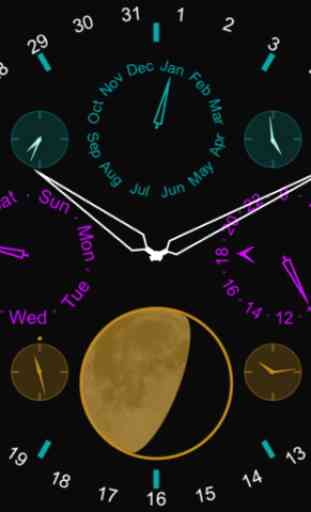Emerald Geneva
Emerald Geneva is a complex analog multi-dial simulation of a mechanical face, with many traditional complications plus a few modern twists. There are 21 hands plus 9 additional indicators. The hours, minutes and seconds are standard (but with no numbers on the dial). There is an am/pm dot just above the 12 o'clock position (white for am, black for pm). The thin gray-blue hand with the circle on the outermost dial indicates the day of the month. The first twist on the classic look is that the day numbers 29 thru 31 appear only as needed.
The white hand with a black tip indicates the last two digits of the year, read against the inner gray dial with 100 divisions (zero is at the 12 o'clock position). The thin white hand with a red tip indicates the two digit century, read against the same dial.
The primary hand of the subdial at 12 o'clock indicates the month. The interior region of that dial, which is marked with the seasons, rotates so that the boundaries between the seasons are properly aligned to the calendar months.
The primary hand on the subdial at 3 o'clock simply shows the current local time in 24-hour format while the small gray-green arrow shows the UT hour. As usual for Emerald Sequoia faces, the local time always follows the local daylight savings time rules (for most jurisdictions; UT never uses DST). If daylight savings time is in effect a "D" will appear in the lower left quadrant; otherwise, an "S" will appear in the lower right. A "+" will appear in the upper right quadrant if the UT date is a day ahead of the local date, and a "-" will appear in the upper left iff it is a day behind; otherwise both upper quadrants will be blank.
The primary hand on the subdial at 9 o'clock shows the day of the week. The tiny hand is another of Geneva's twists, a fully general leap year indicator. It points to 1, 2 or 3 in common years and 4 in regular leap years. But the Gregorian calendar skips 3 leap years every 400 years so the tiny hand points at 100 or 400 if one of the centurial rules applies.
The four small subdials indicate the times of the sunrise, sunset, moonrise and moonset events for the current day. The moonrise and moonset dials have am/pm dots above. If there is no event for the current day the corresponding dial will read 12:00 and the am/pm dot will be red.
The final twist is the moon phase indicator which shows a realistic terminator, rotated to match its actual orientation in the sky, exactly like the one on Emerald Chandra. Superimposed on this is a retrograde hand showing the age of the current lunation.
No network access is required; only the device time and location are used internally.
More information is available at the listed website.
---
Keywords: time,watch,clock,astronomy,sunset,phase,moon,rise,sunrise,mechanical,analog
The white hand with a black tip indicates the last two digits of the year, read against the inner gray dial with 100 divisions (zero is at the 12 o'clock position). The thin white hand with a red tip indicates the two digit century, read against the same dial.
The primary hand of the subdial at 12 o'clock indicates the month. The interior region of that dial, which is marked with the seasons, rotates so that the boundaries between the seasons are properly aligned to the calendar months.
The primary hand on the subdial at 3 o'clock simply shows the current local time in 24-hour format while the small gray-green arrow shows the UT hour. As usual for Emerald Sequoia faces, the local time always follows the local daylight savings time rules (for most jurisdictions; UT never uses DST). If daylight savings time is in effect a "D" will appear in the lower left quadrant; otherwise, an "S" will appear in the lower right. A "+" will appear in the upper right quadrant if the UT date is a day ahead of the local date, and a "-" will appear in the upper left iff it is a day behind; otherwise both upper quadrants will be blank.
The primary hand on the subdial at 9 o'clock shows the day of the week. The tiny hand is another of Geneva's twists, a fully general leap year indicator. It points to 1, 2 or 3 in common years and 4 in regular leap years. But the Gregorian calendar skips 3 leap years every 400 years so the tiny hand points at 100 or 400 if one of the centurial rules applies.
The four small subdials indicate the times of the sunrise, sunset, moonrise and moonset events for the current day. The moonrise and moonset dials have am/pm dots above. If there is no event for the current day the corresponding dial will read 12:00 and the am/pm dot will be red.
The final twist is the moon phase indicator which shows a realistic terminator, rotated to match its actual orientation in the sky, exactly like the one on Emerald Chandra. Superimposed on this is a retrograde hand showing the age of the current lunation.
No network access is required; only the device time and location are used internally.
More information is available at the listed website.
---
Keywords: time,watch,clock,astronomy,sunset,phase,moon,rise,sunrise,mechanical,analog
Category : Tools

Related searches



does not work with TAG Heuer connected